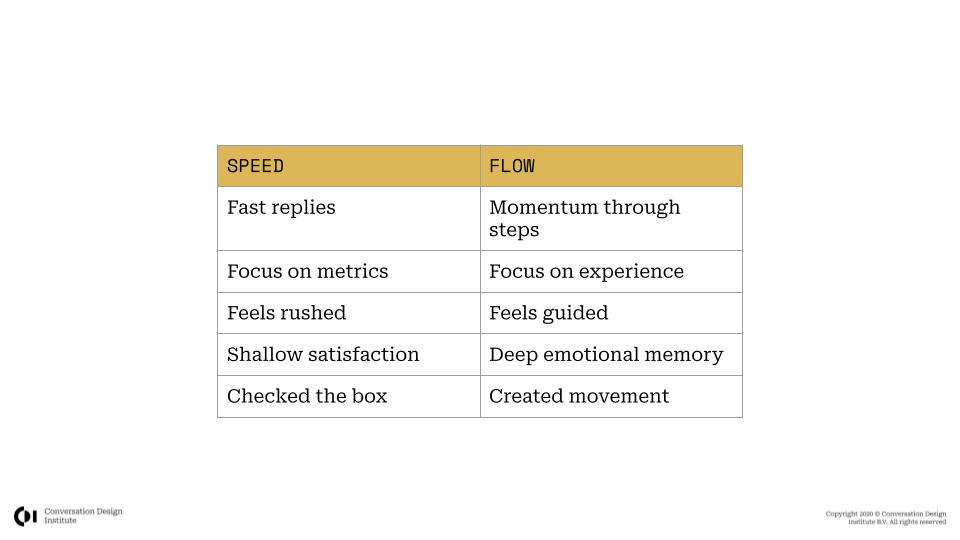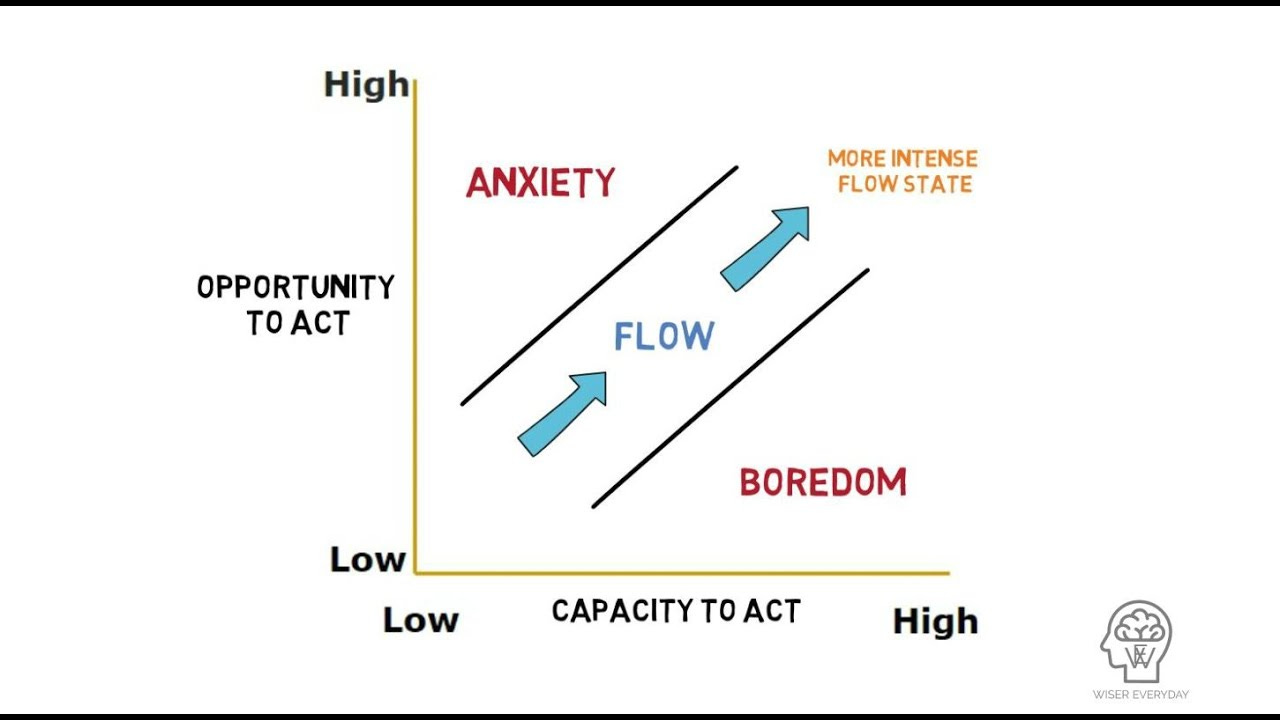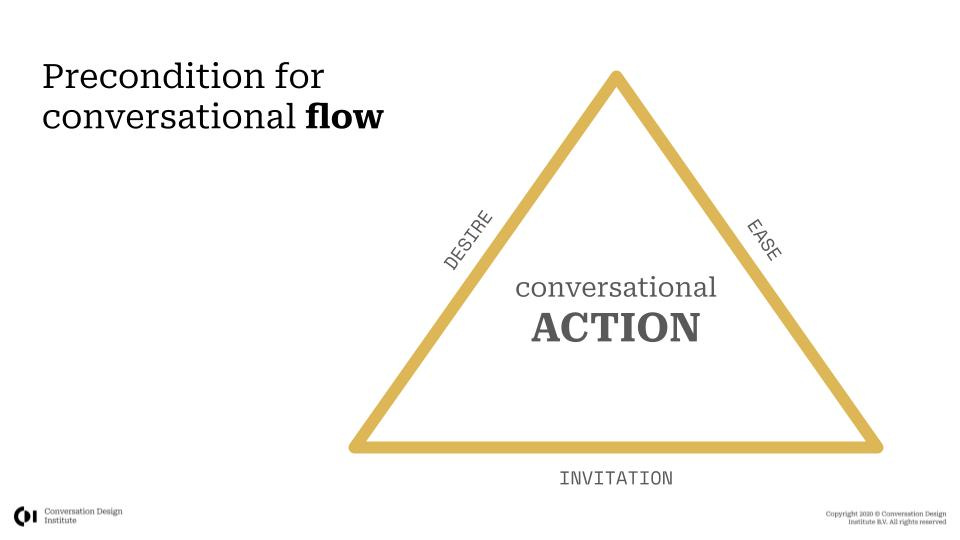Design for Flow, Not Just Speed
Because emotional momentum, not velocity, builds memory and trust.
I. The Tyranny of Speed
In most organizations, speed is sacred.
Customer service teams chase resolution time. Product teams chase tap-through rates. AI teams chase prompt length and token count.
Speed is a clean number. It looks good on a dashboard. It promises progress.
But speed is not satisfaction. And fast doesn’t always mean forward.
We’ve all had fast experiences that left us disoriented, unseen, or flat. The page loaded, the chatbot replied, the box was checked. And yet — we walked away feeling nothing. Or worse, we walked away feeling dismissed.
Fast is forgettable. Flow is unforgettable.
II. The Myth of Speed in Customer Experience
Today’s systems measure:
Average Handle Time (AHT)
First Contact Resolution (FCR)
Containment Rate
These metrics tell us how quickly a system can finish something. They say nothing about whether that system made a person feel safe, understood, or confident.
You can move fast and still leave people behind. You can resolve the issue and still erode the relationship.
Speed without flow becomes just another form of friction.
People don’t just abandon fast systems.
They remember how they were treated.
And that memory becomes the story they share — with themselves, and with others.
III. The Human Psychology of Progress
In the 1970s, psychologist Mihaly Csikszentmihalyi began to study a particular kind of joy:
The chess master lost in strategy.
The climber suspended on a wall.
The writer who forgets the clock.
He called it flow — the state of deep focus and effortless momentum.
It happens when:
You know the goal.
You get feedback along the way.
The challenge stretches you, but doesn’t snap you.
You feel in control.
Too difficult? Anxiety.
Too easy? Boredom.
Just right? Flow.
Flow doesn’t push. It carries.
Jack Dorsey once compared great design to the Golden Gate Bridge.
When you drive across it, you don’t think about engineering. You just flow.
But when you step back, you see the precision, the intent, the poetry in the steel. You remember the alternative – driving all the way across the bay.
That’s what great product feels like. It vanishes in the moment. And reveals its beauty in memory.
IV. Before Flow: Invitation, Desire, Ease
Before people can enter flow, they need to feel safe.
Before momentum, there must be welcome.
This is where your Conversational Action Model (CAM) begins:
Invitation — Am I safe here? Do I belong?
Desire — Do I want to continue?
Ease — Can I move forward without resistance?
If invitation fails, people withdraw.
If desire fails, they disengage.
If ease fails, they give up.
This model isn’t the flow. It’s the moment before.
The soft launch into motion.
A helpful system starts with care, not commands.
It's the difference between being pushed into a process and being welcomed into a conversation.
Great brands don’t just answer. They invite.
They don't just serve. They host.
At CDI, we have defined clear design strategies – grounded in behavioral psychology – that help improve all elements of the CAM. You can also take this self assessment to explore if your organization is ready for such advanced CX strategies.
V. What Flow Feels Like in Conversation
Let’s bring Flow Theory into the world of customer interaction:
Here are some of the things that assistants do to create flow…
Clear Goals "Let’s get that sorted together. Should only take a minute."
Immediate Feedback "Got it — we’re halfway there!"
Balanced Challenge Steps feel thoughtful, never overwhelming
Sense of Progress "Next, let’s confirm a few details..."
Control and Choice "Would you prefer to do this now or later?"
When conversations follow this rhythm, customers don’t just get answers — they gain momentum. They don’t just move through steps — they move forward.
Flow isn’t speed. It’s structure that feels like grace.
And if you work in customer experience, you are not just managing processes.
You are designing moments of emotional progression.
You are the steward of how people move through the hard parts of life.
VI. The Emotional Cost of Disconnection
Let’s make it real.
You forgot your password. You just want to log in and get on with your day.
Scenario 1: AtlasCo Bot
You open chat.
AtlasCo Bot: “Reset instructions sent.”
(No greeting. No context. No follow-up.)
You’re left wondering:
Did it work?
Is there anything else I need to do?
What if I still can’t log in?
Fast? Yes.
Helpful? Technically.
Memorable? No.
Relational? Never.
You close the window with a shrug — or worse, a sigh.
It’s the kind of interaction that makes you feel like a ticket, not a person.
Scenario 2: LuminaBot
You open chat.
LuminaBot: “Hey there — let’s fix this together.”
(Warm. Human. Collaborative.)
You type: “Forgot my password.”
LuminaBot: “No worries — just sent reset instructions to your email. Let me know if you don’t see them.”
You click the link.
LuminaBot: “Looks like you’re back in. Anything else you need?”
“You’re all set. And just so you know, I’m here 24/7 if it happens again.”
Same issue. Same resolution. Entirely different feeling.
Lumina doesn’t just respond — Lumina relates.
It doesn’t just move fast. It moves with you.
That’s what people remember:
The feeling of being accompanied, not processed.
The sense that someone was with you, not just done with you.
Because emotional disconnection has a cost:
Lower trust.
Lower loyalty.
Higher churn.
Higher effort on the next contact.
It’s not just about how fast the bot was.
It’s about how the moment made them feel.
And that feeling becomes the story they carry forward.
VII. Conversation as Design, Design as Care
A great conversation is an emotional landscape. It has a beginning, a middle, and an end.
It carries someone from uncertainty to resolution, from effort to ease.
Viktor Frankl said, “Between stimulus and response, there is a space.”
That space is where care lives. Where experience is shaped.Rachel Botsman defines trust as “a confident relationship with the unknown.”
Flow creates that confidence. Rushed systems erode it.Joseph Campbell gave us the Hero’s Journey. Every customer is their own hero, facing friction, hoping for progress. The job of a great assistant isn’t just to resolve. It’s to guide.
Donald Norman taught us that great design offers clues.
People should never ask, "What do I do next?" Flow doesn’t ask. It shows.
This is what it means to work in CX.
Not to react, but to guide.
Not to close tickets, but to carry people forward.
VIII. How to Design for Flow
✅ Invite Before You Instruct
Use names. Use warmth. Offer the benefit, not the burden.
✅ Build Micro-Progress
Signal steps. Celebrate completion. Use phrases like "Next, we’ll..." or "You’re halfway there."
✅ Use Language with Rhythm
Avoid dead phrases. Use human pacing: "Alright, just one last thing…"
✅ Create Emotional Pulse
Design the conversation like a song. Calm → Clear → Movement → Closure.
✅ Handle Setbacks Gracefully
Avoid blame. Say: "That didn’t go through. Let’s try a different way."
✅ End with Assurance
"All set. You’re in good hands." Closure isn’t just an end.
It’s the emotional seal that makes it stick.
IX. Maturity and Emotional Intelligence
Designing for flow is a signal of organizational maturity.
It shows you’re moving toward emotional intelligence — not just technical optimization.
In our own work, we use the Empathy Algorithm Grid to map emotional intelligence across systems. The best systems aren’t just fast.
They are emotionally fluent.
Flow is what happens when empathy meets rhythm.
When clarity meets invitation.
It’s not automation.
It’s orchestration.
To work in customer experience is to be a designer of dignity.
A choreographer of clarity.
A builder of trust in a world that badly needs it.
X. Final Reflection
Speed is for systems.
Flow is for people.
Design your conversations the way you design a bridge: invisible when it works, beautiful when reflected on.
Flow doesn’t shout. It carries.
Create conversations that:
Invite.
Guide.
Close the loop.
Because customers don’t remember how fast you were.
They remember how it felt to move forward with you.
And if you work in CX, this is your craft.
You are not just answering questions.
You are shaping memory.
Power to the Poets. The future isn’t built with speed alone.
It’s built with structure that disappears, and feeling that remains.
Are you working on something interesting that you want to share with the CDI community? Just fill in this form and our team will reach out to you. We’re really excited to learn from you.






I agree with a lot of this, but not all. I'd like to add 3 thoughts.
First, you need to know your user. Yes, personalisation - use names, ask relevant questions - but it's more than that. Do they go through this process every day/week/month, or are they new to it? Did they have issues last time, or should we expect minimal intervention? Are they talking/typing/clicking? What device are they on? This all makes a difference to how the user wants to complete the task - their objective.
Second, what about the organisation's objective? Is this an automated interaction so basically free for the organisation, and can take as long as the user needs? Is this an opportunity to improve the relationship or customer loyalty, or just a functional interaction like a balance check or a password reset? Remember that friction is another word for stickiness - you can't have one without the other, and sometimes we want stickiness.
Third, speed may be important to customers - but convenience is probably more important. While I agree that flow can make an interaction feel convenient, and speed is then less important, once you lose the convenience (say by too long a greeting or sign-off, or too much Clippy-style "Sure, I can help you with that" fluff), the ease of flow for the user is lost and frustration can quickly follow.